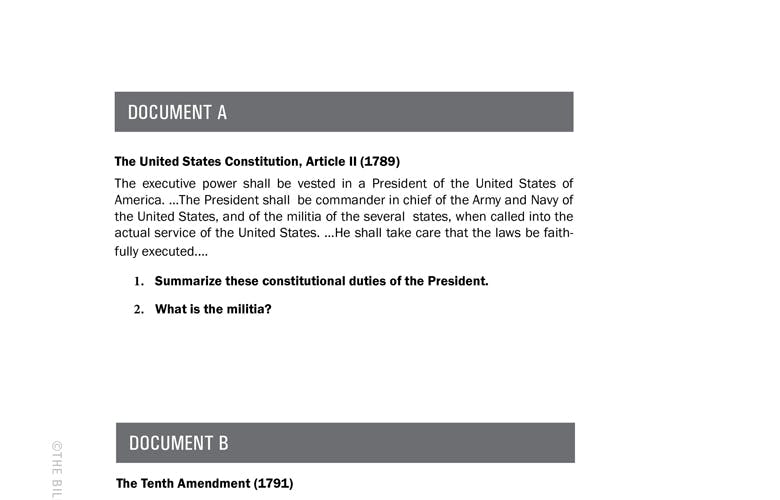Documents to Examine (A-K) – Eisenhower and the Little Rock Crisis (1957)
DOCUMENT A
The United States Constitution, Article II (1789)
The executive power shall be vested in a President of the United States of America. …The President shall be commander in chief of the Army and Navy of the United States, and of the militia of the several states, when called into the actual service of the United States. …He shall take care that the laws be faithfully executed.…
- Summarize these constitutional duties of the President.
- What is the militia?
DOCUMENT B
The Tenth Amendment (1791)
The powers not delegated to the United States by the Constitution, nor prohibited by it to the states, are reserved to the states respectively, or to the people.
- If a power is not given to the national government in the Constitution, who keeps it?
DOCUMENT C
The Fourteenth Amendment (1868)
No state shall … deny to any person within its jurisdiction the equal protection of the laws.
- Put this clause of the Fourteenth Amendment in your own words
DOCUMENT D
“Terrence Roberts and two Arkansas National Guardsmen,” September 4, 1957

- What date was this photograph taken?
- What duties do the National Guard members seem to be carrying out with respect to student Terrence Roberts?
DOCUMENT E
Telegram from Little Rock Mayor Mann to President Eisenhower, 6:24 PM, September 23, 1957



- When was this telegram sent?
- What is Mayor Mann’s message to the President?
- How does Mann describe the “agitators”?
DOCUMENT F
Proclamation 3204, September 23, 1957

- What does President Eisenhower order the people gathered in front of Central High School to do?
- What constitutional authority does he claim?
DOCUMENT G
Telegram from Mayor Mann to President Eisenhower, 9:16 AM, September 24, 1957


- When was this telegram sent?
- How does the message in this telegram differ from Mann’s telegram in Document E? Why is this significant?
DOCUMENT H
Executive Order 10730, September 24, 1957
EXECUTIVE ORDER 10730
PROVIDING ASSISTANCE FOR THE REMOVAL OF AN
OBSTRUCTION OF JUSTICE WITHIN THE STATE OF ARKANSAS
… WHEREAS the command contained in … Proclamation [3204] has not been obeyed and willful obstruction of enforcement of said court orders still exists and threatens to continue.…
Section 1. I hereby authorize and direct the Secretary of Defense to order into the active military service of the United States as he may deem appropriate to carry out the purposes of this Order, any or all of the units of the National Guard of the United States and of the Air National Guard of the United States within the State of Arkansas to serve in the active military service of the United States for an indefinite period and until relieved by appropriate orders.
SEC. 2. The Secretary of Defense is authorized and directed to take all appropriate steps to enforce any orders of the United States District Court for the Eastern District of Arkansas for the removal of obstruction of justice in the State of
Arkansas with respect to matters relating to enrollment and attendance at public schools in the Little Rock School District, Little Rock, Arkansas….
- What type of document is this?
- Why does Eisenhower refer to his earlier proclamation (Document F)?
- What action does Eisenhower “authorize and direct” in Section 1?
- What action does Eisenhower “authorize and direct” in Section 2?
DOCUMENT I
“Operation Arkansas: A Different Kind of Deployment Photo,” September 25, 1957

- What date was this photograph taken?
- What duties are the members of the 101st Airborne Division carrying out with respect to the African American students?
- Why might this photo have been entitled “A Different Kind of Deployment Photo”?
DOCUMENT J
“Bayonet Point,” September 25, 1957

- What duties are the members of the 101st Airborne Division carrying out with respect to the integration protestors?
- How does this action compare with the one depicted in Document D?
DOCUMENT K
Eisenhower’s Address to the Nation, September 24, 1957
Our personal opinions about the [Brown v. Board of Education] decision have no bearing on the matter of enforcement. …During the past several years, many communities in our Southern States have instituted [integration] plans. They thus demonstrated to the world that we are a nation in which laws, not men, are supreme. I regret to say that this truth—the cornerstone of our liberties—was not observed [at Central High School in Little Rock]….
The very basis of our individual rights and freedoms rests upon the certainty that the President and the Executive Branch of Government will support and insure the carrying out of the decisions of the Federal Courts, even, when necessary with all the means at the President’s command. Unless the President did so, anarchy would result. There would be no security for any except that which each one of us could provide for himself. …Mob rule cannot be allowed to override the decisions of our courts.
The running of our school system and the maintenance of peace and order in each of our States are strictly local affairs and the Federal Government does not interfere except in a very few special cases and when requested by one of the several States. In the present case the troops are there, pursuant to law, solely for the purpose of preventing interference with the orders of the Court. The proper use of the powers of the Executive Branch to enforce the orders of a Federal Court is limited to extraordinary and compelling circumstances. Manifestly, such an extreme situation has been created in Little Rock….
- What does Eisenhower mean when he says the US is “a nation in which laws, not men, are supreme”?
- What “certainty” does Eisenhower call the “very basis of our individual rights and freedoms”?
- What two conditions does Eisenhower state must be present in order for the federal government to interfere in state and local affairs?
